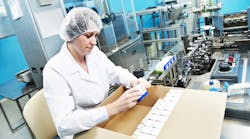Manufacturing methods in the life sciences industry are in the midst of dramatic transformation. Single-use manufacturing technologies, after a long “trial” period, have come into their own as a mainstream option, offering a combination of lower capital costs, flexibility, and reduced cleaning. Continuous manufacturing is also gaining traction, including recent regulatory approvals, with those looking for the highest production capacity with the smallest footprint.
When discussing new techniques, the conversation tends to focus primarily around the production process, physical equipment, operational characteristics and relative costs. However, the automation technology required to support these new approaches is just as important as the inherent attractiveness of the manufacturing process itself. If suitable measurement products, control software and hardware, and record collection capabilities are not available from dependable suppliers in an easy-to-deploy manner, then the promise of these new methods can’t be broadly recognized. We can’t fully realize the benefits of breakthrough technologies if highly customized and expensive automation is required to make it a reality.
[pullquote]One example is sensing technology for single-use applications. In traditional manufacturing, sensors and their electronics are permanently installed in fixed equipment and periodically calibrated for compliance. When sensors for single-use manufacturing contact the process, they must be disposable if the single-use promise of reduced cleaning is to be recognized. This has driven the development of new, sterile sensor components that measure different properties and are plugged into placeholders in the throwaway bag, and then connected to fixed, reusable electronics with all the calibration, self-diagnostics and electronics of traditional, permanently mounted instruments.
When control equipment (DCS, PLC, etc.) and software are considered, we find the current generation has mostly been designed for the traditional stainless steel vessel batch manufacturing processes. Integrated, sophisticated batch software has been developed that works well in these configurations, but it expects equipment configurations to be fixed or to have a limited number of permutations directly incorporated in the software.
Conversely, when we look at single-use, one major envisioned advantage is modularity and the ability to “mix and match” potentially mobile unit operations to meet a specific manufacturing process. Once this “new” process is established, it is highly desirable to have it appear as an integrated process to the operations staff, similar to permanent construction. This challenges the control system software that runs these processes. Automation companies have responded by developing modular controllers that can be attached to each of these unit operations and provide autonomous control and visualization. When networked together, these controllers automatically merge configurations into a single integrated database to provide a unified operational view.
Continuous manufacturing brings the opposite challenge: Unit operations are highly coupled to each other, and control functions must consider the impact an action in one operation will potentially have on another. During product transitions, control software must “learn” and react to the changed control characteristics of the specific process associated with the specific product. In fact, unless the right control software technology is available, the process can’t be reliably operated as envisioned — much like it took new computer-driven flight control technology to enable a new generation of more maneuverable jet fighter aircraft with highly coupled control surfaces.
New manufacturing techniques are enabling more cost-effective personalized meds, lower capital cost facilities, faster time to market and increased production. The development of the automation technologies that enable them to do so are vitally important to their broad-scale deployment. The future continues to be bright for pharma businesses not just because the processes and process technologies are being revolutionized, but also because the underlying control solutions are keeping pace with these advances.





